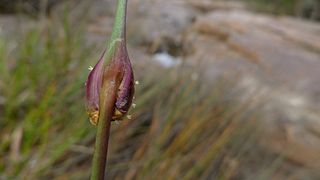| Cyperus nutans | |
|---|---|
| Scientific classification | |
| Kingdom: | Plantae |
| Clade: | Tracheophytes |
| Clade: | Angiosperms |
| Clade: | Monocots |
| Clade: | Commelinids |
| Order: | Poales |
| Family: | Cyperaceae |
| Genus: | Cyperus |
| Species: | C. nutans |
| Binomial name | |
| Cyperus nutans | |
| Synonyms [1] | |
Cyperus bispicatusSteud. | |
Cyperus nutans is a sedge of the family Cyperaceae that is native to Australia, [2] China, India, Bangladesh, south-east Asia, Malaysia, India, and Indonesia. [1]
Contents
The rhizomatous perennial sedge typically grows to a height of 1.5 metres (4.9 ft). [2] The culms are three sided with sharp edges and concave sides. The culms are typically up 100 cm (39 in) in length and have a diameter of 10 mm (0.39 in). The leaves are usually shorter than the culms and have a width of around 6 to 12 mm (0.24 to 0.47 in). [3] It blooms between February and July and produces brown flowers. [2] Each compound inflorescence has six to ten primary branches up to a length of 30 cm (12 in). The narrow-cylindrical spikes have a length of 2 to 3 cm (0.79 to 1.18 in) with a 5 mm (0.20 in) diameter. After flowering a dark brown narrow-ellipsoid to narrow-obovoid shaped nut will form. [3]
The species was first formally described by the botanist Martin Vahl in 1805 as part of the work Enumeratio Plantarum, from a specimen collected in India. [4] [5] The only two subspecies are Cyperus nutans subsp. nutans and Cyperus nutans var. nutans. [6]
The plant is found in northern and eastern Australia in coastal areas in the states of New South Wales, Queensland, Northern Territory and Western Australia. [6] In Western Australia it is found around shady swamps and pools in the Kimberley region where it grows in sandy-clay soils. [2] In New South Wales it is only found in the north-eastern corner where it is found along creek banks. [3]














